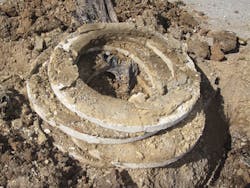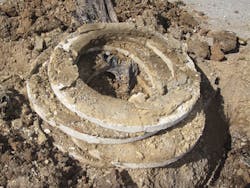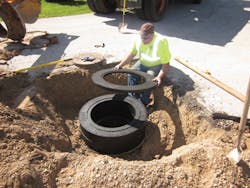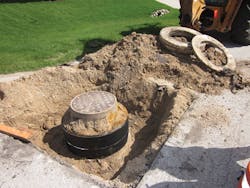Manhole Grade Adjustment System
Like many municipalities in the northern Midwestern states, the town of Sheboygan, Wis., faced challenges in keeping at-grade manholes in good repair. Snow-covered roads, freezing temperatures, and the use of salt and ice-melting compounds throughout the winters took their toll on the concrete rings that brought manhole covers up to road grade. Cracked and crumbling concrete caused leaks, which in turn led to cracks in the road and potholes as winters wore on. This created the need to make frequent repairs when spring and summer arrived - which meant traffic tie-ups on busy public roads.
“It used to take two or three days to get the road back in operation,” noted Bill Blashka, director of public works for the town of Sheboygan. “The biggest problem was needing to use heavy equipment to replace the concrete rings. We had to put 12 to 16 inches of concrete rings on, and we would get the rings in thicker sections so we didn’t have all the joints where you need mortar because those can leak.”
Two strong workers could lift and maneuver a slim concrete ring but the ones that were a foot thick or more were too heavy for crewmembers to carry. Some workers had even been hit by moving or falling rings and suffered injuries.
“We needed heavy machinery to move the rings,” said Blashka. “So then we had a big machine at a manhole repair - and people could still get hurt. Meanwhile, the machines messed up traffic.”
Concrete rings require layers of mortar between them, which need time to set up and cure before workers can complete the installation and backfill the manhole. This means that a manhole repair job can stand open for days until crew can backfill and get their equipment off the roads.
Meanwhile, deteriorating mortar between layers of concrete and cracked concrete rings create issues with inflow and infiltration (I&I). Cracks at or near grade allow clear water to enter the sewer system from the road, while crumbling mortar below grade permits groundwater to seep into the sewer collection system.
So when Blashka heard that Cretex Specialty Products in nearby Waukesha had a new product for manhole grade adjustment, he took an immediate interest.
The PRO-RING™ Manhole Grade Adjustment System is made from ARPRO® expanded polypropylene (EPP), the engineered polymer that has been in use in the automotive industry for decades. The lightweight plastic offers a level of durability that makes it a long-lasting replacement for masonry materials like concrete and mortar. A proven performance material, EPP has shown high resistance to chemicals in harsh automotive environments, demonstrating its long service life.
The PRO-RING system includes EPP rings up to six inches in thickness that weigh about 14 pounds each (thinner rings weigh less). One worker can easily lift even the largest rings, eliminating the need for heavy machinery to lift and move rings into place on the manhole. The system includes grade rings to build the manhole up close to grade level, finish rings to create a level surface, and angle rings to make the final match between the slope of the road surface and the manhole. Square and rectangular PRO-RING systems are available as well for use on catch basins and other underground structures.
Instead of mortar, the PRO-RING system requires only a bead of adhesive/sealant between rings to seal and hold them in place, removing the possibility that crumbling mortar will cause I&I issues. A solo worker or a crew of two can install the system in just a few minutes.
Sheboygan began using PRO-RING in 2012 and the results have been measurably positive, said Blashka. “The only thing we need the heavy equipment for is to dig up the manhole and to fill in the dirt afterward,” he said. “We can even do it with smaller machines, and it’s quicker. We save hours using PRO-RING instead of concrete grade rings.”
With no lag time between installation and backfill, workers can complete the entire job in a day or less. “We can compact gravel around the rings right away, making pavement replacement faster,” said Blashka. “This allows the road to be opened up to traffic the same day instead of a day or two later.”
Already the incidence of leaks has gone down considerably, Blashka said. “We have experienced no pavement issues since starting to use the PRO-RING system four years ago,” he noted. “So far, we have reconstructed about 80 manholes with no issues.”
Perhaps best of all, the town of Sheboygan has saved money over the long run with the new EPP product. “The initial cost of the PRO-RING is more than that of concrete, but taking into account the faster installation, the ability to get the roadway open sooner, and the durability, PRO-RING is less expensive,” said Blashka.
The crews make sure that Blashka knows how pleased they are with PRO-RING. “Our staff in the field wishes we were using the product for longer,” he said. “The guys toss the rings back and forth all the time - no more injuries. The system has performed great.”
For more information about the PRO-RING Manhole Grade Adjustment System, visit www.cretexseals.com, call Cretex Specialty Products at 800-345-3764, or email [email protected].



